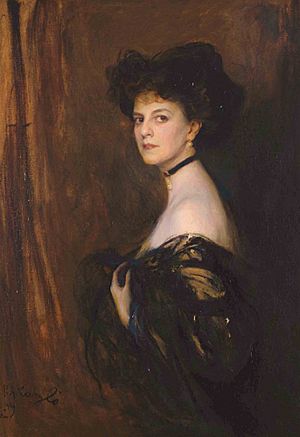In Search of Lost Time facts for kids
In Search of Lost Time (French: À la recherche du temps perdu) is a very long novel by French writer Marcel Proust. It was first translated into English as Remembrance of Things Past.
This famous book is made up of seven volumes. It gained popularity in English thanks to translations by C. K. Scott Moncrieff and Terence Kilmartin. The title In Search of Lost Time is a direct translation from the French. It became the most common title after D. J. Enright used it for his updated translation in 1992.
The story follows a narrator as he remembers his childhood and grows up. It takes place in France in the late 1800s and early 1900s. The book explores the lives of people in high society. It also makes readers think about how time passes and what life means.
Proust started writing the novel in 1909. He worked on it until he became very ill in 1922. He had planned the book's structure early on. Even after finishing some volumes, he kept adding new parts and editing them for publication. The last three volumes were not fully polished when Proust died. His brother, Robert, helped edit and publish these final parts.
The book was published in France between 1913 and 1927. Proust even paid to publish the first volume himself. This was after many big publishers had said no to his handwritten story. Some of the ideas and scenes in this novel were first seen in Proust's earlier, unfinished works. These included Jean Santeuil and Contre Sainte-Beuve.
In Search of Lost Time had a big impact on literature in the 1900s. Some writers tried to write similar books. Others wrote funny versions of it. For the 100th anniversary of the first volume's publication, American author Edmund White called it "the most respected novel of the twentieth century."
The Story's Main Ideas
In Search of Lost Time is a deep look into memory and how it works. The narrator often remembers things from his past. These memories are sometimes triggered by everyday things. A famous example is when he tastes a madeleine cake. This taste brings back a flood of childhood memories.
The book also explores how people change over time. It shows how relationships develop and how society works. Proust uses long, detailed sentences to describe feelings and thoughts. This helps readers really get inside the narrator's mind.
The Seven Volumes
The novel is divided into seven main parts. Each part tells more of the narrator's story.
| Volume | French Title | Published | English Title |
|---|---|---|---|
| 1 | Du côté de chez Swann | 1913 | Swann's Way |
| 2 | À l'ombre des jeunes filles en fleurs | 1919 | Within a Budding Grove |
| 3 | Le Côté de Guermantes | 1920/21 | The Guermantes Way |
| 4 | Sodome et Gomorrhe | 1921/22 | Cities of the Plain |
| 5 | La Prisonnière | 1923 | The Captive |
| 6 | La Fugitive | 1925 | The Fugitive |
| 7 | Le Temps retrouvé | 1927 | Time Regained |
Related pages
Images for kids
-
The beach at Cabourg, a seaside town that was the real-life model for Balbec in the novel.
-
The Destruction of Sodom and Gomorrah by John Martin, 1852. The fourth volume of the novel talks about the people from these two Biblical cities.
See also
 In Spanish: En busca del tiempo perdido para niños
In Spanish: En busca del tiempo perdido para niños








